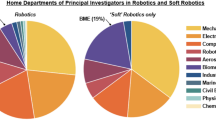Abstract
Purpose
Natural orifice transluminal endoscopic surgery (NOTES) is a next generation surgical method with many promising benefits. Many snake-like NOTES platforms have been developed, but the lack of a proper control algorithm prevents those platforms from being used in practices. This study proposes an intuitive control algorithm for snake-like NOTES platforms, which is simple in structure and easily applicable to various NOTES systems.
Methods
An intuitive snake-like NOTES platform control algorithm based on the motion history and insertion depth data is proposed. The operator directly controls the head module of the platform while the rest of the platform follows the motion of the head module according to the insertion depth. Also, the orientation of the head module is set to be constant for intuitive control. The algorithm was verified through various simulations.
Results
Several random and anatomical paths were prepared to validate the performance of the proposed algorithm and it was found that the proposed algorithm was able to guide the NOTES platform into the desired location.
Conclusions
The proposed algorithm provides an intuitive and efficient way of controlling snake-like NOTES platforms and we expect that the proposed algorithm will help surgeons performing NOTES.
Similar content being viewed by others
References
McGee MF, Schomisch SJ, Marks JM, Delaney CP, Jin J, Williams C, Chak A, Matteson DT, Andrews J, Ponsky JL. Late phase TNF-alpha depression in natural orifice translumenal endoscopic surgery (NOTES) peritoneoscopy. Surgery. 2008; 143(3):318–28.
Pham BV, Morgan K, Romagnuolo J, Glenn J, Bazaz S, Lawrence C, Howes R. Pilot comparison of adhesion formation following colonic perforation and repair in a pig model using a transgastric, laparoscopic, or open surgical technique. Endoscopy. 2008; 40(8):664–9.
Kalloo AN, Singh VK, Jagannath SB, Niiyama H, Hill SL, Vaughn CA, Magee CA, Kantsevoy SV. Flexible transgastric peritoneoscopy: a novel approach to diagnostic and therapeutic interventions in the peritoneal cavity. Gastrointestest Endosc. 2004; 60(1):114–7.
Rattner D, Kalloo AN. ASGE/SAGES working group on natural orifice transluminal endoscopic surgery. Surg Endosc. 2006; 20(2):329–33.
Ikuta K, Hasegawa T, Daifu S. Hyper redundant miniature manipulator “hyper finger” for remote minimally invasive surgery in deep area. Conf Proc IEEE Int Conf Robot. 2003; 1:1098–102.
Salle D, Bidaud P, Morel G. Optimal design of high dexterity modular MIS instrument for coronary artery bypass grafting. Conf Proc IEEE Int Conf Robot. 2004; 2:1276–81.
Yamashita H, Iimura A, Aoki E, Suzuki T, Nakazawa T, Kobayashi E, Hashizume M, Sakuma I, Dohi T. Development of endoscopic forceps manipulator using multi-slider linkage mechanisms. Conf Proc Asian Symp Comput Aided Surg, 2005 vol.1 no.1 p.1–4.
Degani A, Choset H, Wolf A, Zenati MA. Highly Articulated Robotic Probe for Minimally Invasive Surgery. Conf Proc IEEE Int Conf Robot. 2006; 1:4167–72.
Shang J, Noonan DP, Payne C, Clark J, Sodergren MH, Darzi A, Yang GZ. An articulated universal joint based flexible access robot for minimally invasive surgery. Conf Proc IEEE Int Conf Robot. 2011; 1147–52.
Chirikjian GS, Burdick JW. A modal approach to hyperredundant manipulator kinematics. IEEE T Robotic Autom. 1994; 10(3):343–54.
Andersson SB, Discrete approximations to continuous curves. Conf Proc IEEE Int Conf Robot. 2006; 2546–51.
Hatton RL, Choset H. Generating gait for snake robot by annealed chain fitting and keyframe wave extraction. Autonomous Robots. 2010; 28(3):271–81.
Fahimi F, Ashrafiuon H, Nataraj C. An improved inverse kinematic and velocity solution for spatial hyper-redundant robots. IEEE T Robotic Autom. 2002; 18(1):103–7.
Kwok KW, Tsoi KH, Vitiello V, Clark J, Cho GCT, Luk W, Yang GZ. Dimension reduction in controlling articulated snake robot for endoscopy under dynamic active constraints. IEEE T Robotic Autom. 2012; 29(1):15–31.
Mochiyama H, Kobayashi H. The shape Jacobian of manipulator with hyper degrees of freedom. Conf Proc IEEE Int Conf Robot. 1999; 4:2837–42.
Choset H, Henning W. A follow the leader approach to serpentine robot motion planning. ASCE J Aerospace Eng. 1999; 12(2):65–73.
Sciabicco L, Siciliano B. Modelling and control of robot manipulators. 2nd ed. London: Springer-Verlag; 2000.
Kim MJ, Kim KG, Lee JH, Son J, Jung HC, Oh JH, Sohn DK. Analysis of the anatomical characteristics of the pelvis in Koreans to aid in development of a NOTES platform. Surg Innov. 2013; 20(2):134–41.
Chen IM, Yeo SH, Gao Y. Locomotive gait generation for inchworm like robots using finite state approach. Robotica. 2001; 19(5):535–42.
Tesch M, Lipkin K, Brown I, Hatton R, Peck A, Rembisz J, Choset H. Parameterized and scripted gaits for modular snake robots. Adv Robotics. 2009; 23(9):1131–58.
Park JH, Lee S, Lee KC, Lee YJ. Implementation of IEC61800 based EtherCAT slave module for real-time multi-axis smart driver system. Conf Proc IEEE Int Conf Control Autom Syst. 2010; 1:682–5.
Author information
Authors and Affiliations
Corresponding author
Rights and permissions
About this article
Cite this article
Cho, C.N., Jung, H., Son, J. et al. An intuitive control algorithm for a snake-like natural orifice transluminal endoscopic surgery platform: A preliminary simulation study. Biomed. Eng. Lett. 6, 39–46 (2016). https://doi.org/10.1007/s13534-016-0209-3
Received:
Revised:
Accepted:
Published:
Issue Date:
DOI: https://doi.org/10.1007/s13534-016-0209-3




